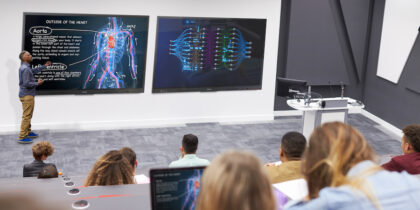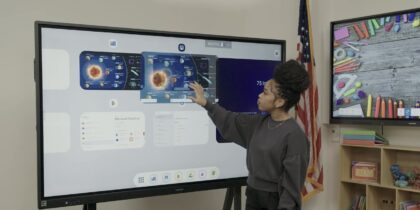Immersive virtual reality isn’t just for gaming. It’s poised to have a big impact on education as well, giving students an opportunity to interact with content in three-dimensional learning environments, and even help them pick the right college.
The Rise of HMDs
For years, futurists have been predicting the use of immersive virtual reality headsets as an instructional tool, and in the past year, this is starting to become a reality with the emergence of affordable head-mounted displays (HMDs), such as Samsung’s Gear VR which is based on technology from Oculus Rift. HMDs sold about 140,000 units in 2015 and are expected to sell about 1.43 million units in 2016 and 6.31 million units in 2017, according to a forecast from Gartner.
Using Virtual Reality in the Classroom
Brian Blau, research vice president for Gartner’s Personal Technologies: Innovation division, says he is unsure how many of those sales will be for education, but he sees many opportunities for schools to take advantage of this technology, from occupational training to investigative learning.
“I’m a big believer in giving kids immersive virtual reality technologies,” says Blau. “It’s such a powerful platform, and it will bring the world to kids wherever they are. Because it’s immersive and 3D, their experiences have a real potential to be much more personal and meaningful.”
Benjamin Lloyd, a technology teacher at Highland Park Middle School in Beaverton, Oregon, used DonorsChoose to fund the purchase of a Gear VR unit and a Samsung Galaxy smartphone for his classroom. He said he wanted to expose his students to emerging technologies and encourage them to become not just consumers, but creators of content.
Virtual reality education “is compelling, it’s interesting, and it’s super engaging for kids,” he says. “When I show them some of the virtual reality stuff, they’re coming before school to check it out. That’s definitely a huge bonus in terms of getting kids to buy in to what we’re doing.”
Lloyd has used Labster, a virtual reality education app that simulates a crime scene for students to investigate, with the Gear VR. He’s also had his eighth graders record their own videos in stereoscopic 3D for use with the Gear VR unit.
Potential in Higher Education
The 2016 Horizon Report from the New Media Consortium predicted that immersive virtual reality technology is likely to have a large impact on teaching and learning in higher education worldwide in the next two to three years.
According to the report, engineering students at Pennsylvania State University who were tasked with virtually assembling an object completed the project more efficiently when using a VR headset and a haptic glove, compared to students who used a mouse, keyboard and computer program. Similarly, nursing students at Boise State are using VR headsets to learn proper procedures for inserting catheters. The virtual reality method has been successful because it’s less expensive, requires less space and provides better real-time feedback for students than using traditional mannequins.
“The compelling aspect of virtual reality is its ability to transport learners into environments and situations that they otherwise may never have access to,” said Samantha Adams Becker, senior director of publications and communications for the New Media Consortium. “Being able to walk among dinosaurs in a fifth grade history class, being able to simulate surgeries for medical students — the potential applications are as unlimited as one’s imagination.”
As virtual reality gains popularity in the classroom, it’s clear to see it has the potential to inspire students to engage with content in new and exciting ways.
For more ideas on how to use technology to improve your students’ learning experience, visit Samsung’s education solutions page.







